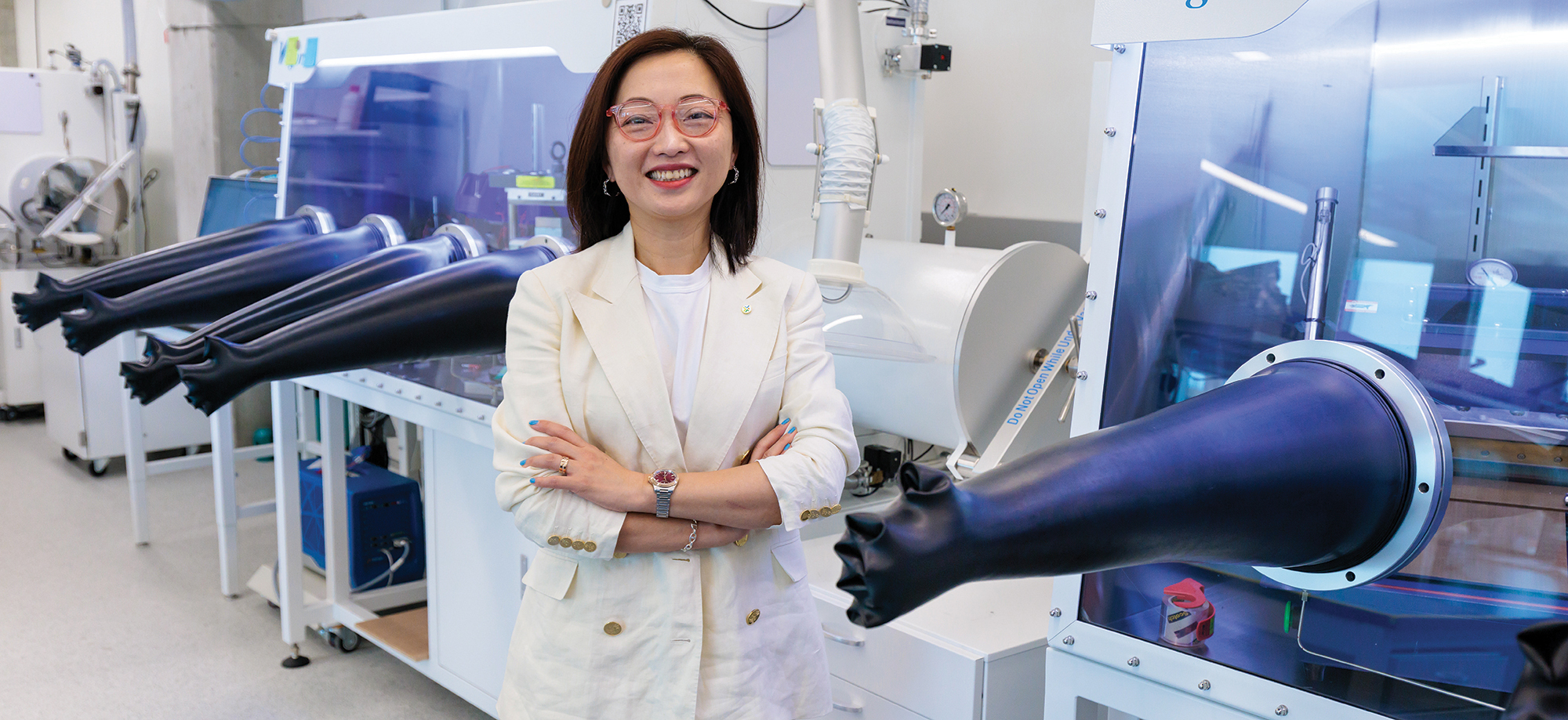
In addition to their potential applications, the new materials represent an important breakthrough in fundamental science, says Y. Shirley Meng. (Photography by John Zich)
New materials that defy the laws of thermodynamics could revolutionize batteries, buildings, and more.
What expands when crushed, shrinks when heated, and could both change scientists’ fundamental understanding of materials and return old electric vehicle batteries to factory-fresh performance levels?
It’s not a riddle. It’s a slate of materials discovered by battery researchers from the Pritzker School of Molecular Engineering and visiting researchers at the University of California, San Diego (UCSD), and described in a recent Nature paper. As part of a long-term research collaboration, the team found negative thermal expansion in metastable oxygen-redox active materials.
More simply put, they created materials that seemingly violate the laws of thermodynamics. When the materials are in their stable state, they react to heat, pressure, or electricity like any other material. But in a particular metastable state discovered by the team, those reactions are flipped.
“When heated, the material shrinks instead of expanding,” says Liew Family Professor in Molecular Engineering Y. Shirley Meng, who also serves as faculty director for the Energy Technology Initiative of the recently launched Institute for Climate and Sustainable Growth. “We think we can tune these materials’ properties through redox chemistry. That can lead to very exciting applications.”
“Redox” is short for oxidation-reduction, a chemical balancing act controlling how electrons transfer between atoms, molecules, ions, or other chemical species. The team hopes to fine-tune the process to create other new materials in the future.
“One of the goals is bringing these materials from research to industry,” says co–first author Bao Qiu, a visiting scholar at UCSD from China’s Ningbo Institute of Materials Technology and Engineering. For example, the new materials could be used to create improved batteries with higher specific energy—that is, more energy per unit mass.
Beyond the myriad new technologies enabled by this discovery, the research represents an advance in pure science. To Meng, that is even more exciting. “This changes our understanding of fundamental science,” she says. “Our work has been guided by UChicago’s model, a model that promotes inquiry and knowledge for its own sake.”
The potential applications are tantalizing too. By finely tuning the ways these materials react to heat and other forms of energy, researchers could create materials that don’t expand when heated. This could revolutionize areas such as construction.
“Zero-thermal-expansion materials are the dream,” says Minghao Zhang, a research associate professor at PME and a co–corresponding author of the work. “Take every single building, for example. You don’t want the materials making up different components to change volume that often with the temperature outside.”

But heat is only one form of energy. To test how the materials react to mechanical energy, the researchers compressed one of them on the gigapascal level—a pressure level so high it is usually reserved for discussing tectonic plate activity. They found what they call “negative compressibility.” “Negative compressibility is just like negative thermal expansion,” Zhang says. “If you compress a particle of the material in every direction, you will imagine, naturally, it will shrink. But this material, it will expand.”
A material tuned to resist heat or pressure could enable some previously theoretical “wild ideas,” Zhang says. He gives the example of structural batteries, which both store energy and carry mechanical loads. They’re an emerging technology still mostly found in labs, but the new materials could make these batteries practical. Imagine an electrically powered airplane whose walls are part of the battery, helping create lighter, more efficient aircraft. These new materials could keep the battery components safe from the changes in temperature and pressure seen at different altitudes.
As with heat and pressure, the meta-stable materials’ reaction to electrochemical energy—voltage—is also flipped.
“This is important not only as a scientific discovery but very applicable for battery research,” Zhang says. “When we use the voltage, we drive the material back to its pristine state. We recover the battery.”
To understand metastability, picture a ball on a hill. The ball is unstable at the top of the hill. It will roll down. It’s stable at the bottom of the hill. It won’t roll up. Metastable is in between: a ball near the top of the hill but nestled in a divot. That metastable state can be quite durable—diamonds are a metastable form of graphite, for example. But energy is needed to push a metastable material out of its “divot” so it can roll back to its stable state.
“To drive the materials back from the metastable state to a stable state, you don’t have to always use heat energy,” Zhang said. “You can use any sort of energy to drive the system back.”
This sets a path toward resetting aging electric vehicle batteries. After years on the road, an electric car that once got, for example, 400 miles to a charge, will drive only 300 or 200 miles before needing to plug in. Using the electrochemical driving force to push the materials into their original states would return the car to the mileage it saw when new.
“You don’t have to send the battery back to the manufacturer or to any vendors. You just do this voltage activation,” Zhang said. “Then your car will be a new car. Your battery will be a new battery.”
Qiu says the next steps are to continue to use redox chemistry to examine the materials and “pull out the key points,” exploring the boundaries of this new area of fundamental research.
